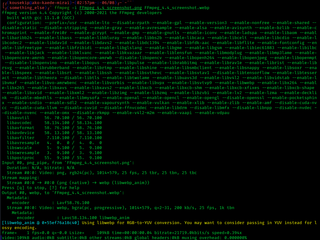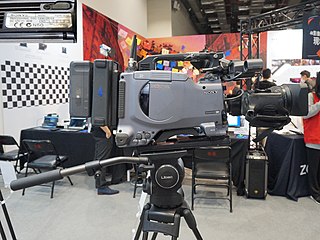Related Research Articles

MPEG-2 is a standard for "the generic coding of moving pictures and associated audio information". It describes a combination of lossy video compression and lossy audio data compression methods, which permit storage and transmission of movies using currently available storage media and transmission bandwidth. While MPEG-2 is not as efficient as newer standards such as H.264/AVC and H.265/HEVC, backwards compatibility with existing hardware and software means it is still widely used, for example in over-the-air digital television broadcasting and in the DVD-Video standard.

DV is a family of codecs and tape formats used for storing digital video, launched in 1995 by a consortium of video camera manufacturers led by Sony and Panasonic. It includes the recording or cassette formats DV, MiniDV, DVCAM, Digital8, HDV, DVCPro, DVCPro50 and DVCProHD. DV has been used primarily for video recording with camcorders in the amateur and professional sectors.
Material Exchange Format (MXF) is a container format for professional digital video and audio media defined by a set of SMPTE standards. A typical example of its use is for delivering advertisements to TV stations and tapeless archiving of broadcast TV programs. It is also used as part of the Digital Cinema Package for delivering movies to commercial theaters.
Dirac is an open and royalty-free video compression format, specification and software video codec developed by BBC Research & Development. Dirac aimed to provide high-quality video compression for Ultra HDTV and competed with existing formats such as H.264.
Motion JPEG is a video compression format in which each video frame or interlaced field of a digital video sequence is compressed separately as a JPEG image.

FFmpeg is a free and open-source software project consisting of a suite of libraries and programs for handling video, audio, and other multimedia files and streams. At its core is the command-line ffmpeg tool itself, designed for processing of video and audio files. It is widely used for format transcoding, basic editing, video scaling, video post-production effects and standards compliance.
Windows Media Video (WMV) is a series of video codecs and their corresponding video coding formats developed by Microsoft. It is part of the Windows Media framework. WMV consists of three distinct codecs: The original video compression technology known as WMV, was originally designed for Internet streaming applications, as a competitor to RealVideo. The other compression technologies, WMV Screen and WMV Image, cater for specialized content. After standardization by the Society of Motion Picture and Television Engineers (SMPTE), WMV version 9 was adapted for physical-delivery formats such as HD DVD and Blu-ray Disc and became known as VC-1. Microsoft also developed a digital container format called Advanced Systems Format to store video encoded by Windows Media Video.
The Advanced Authoring Format (AAF) is a file format for professional cross-platform data interchange, designed for the video post-production and authoring environment. It was created by the Advanced Media Workflow Association (AMWA), and is now being standardized through the Society of Motion Picture and Television Engineers (SMPTE).

VirtualDub is a free and open-source video capture and video processing utility for Microsoft Windows written by Avery Lee. It is designed to process linear video streams, including filtering and recompression. It uses AVI container format to store captured video. The first version of VirtualDub, written for Windows 95, to be released on SourceForge was uploaded on August 20, 2000.
SMPTE 421, informally known as VC-1, is a video coding format. Most of it was initially developed as Microsoft's proprietary video format Windows Media Video 9 in 2003. With some enhancements including the development of a new Advanced Profile, it was officially approved as a SMPTE standard on April 3, 2006. It was primarily marketed as a lower-complexity competitor to the H.264/MPEG-4 AVC standard. After its development, several companies other than Microsoft asserted that they held patents that applied to the technology, including Panasonic, LG Electronics and Samsung Electronics.

XDCAM is a series of products for digital recording using random access solid-state memory media, introduced by Sony in 2003. Four different product lines – the XDCAM SD, XDCAM HD, XDCAM EX and XDCAM HD422 – differ in types of encoder used, frame size, container type and in recording media.
A container format or metafile is a file format that allows multiple data streams to be embedded into a single file, usually along with metadata for identifying and further detailing those streams. Notable examples of container formats include archive files and formats used for multimedia playback. Among the earliest cross-platform container formats were Distinguished Encoding Rules and the 1985 Interchange File Format.
These tables compare features of multimedia container formats, most often used for storing or streaming digital video or digital audio content. To see which multimedia players support which container format, look at comparison of media players.
Avid DNxHD is a lossy high-definition video post-production codec developed by Avid for multi-generation compositing with reduced storage and bandwidth requirements. It is an implementation of SMPTE VC-3 standard.
.m2ts is a filename extension used for the Blu-ray disc Audio-Video (BDAV) MPEG-2 Transport Stream (M2TS) container file format. It is used for multiplexing audio, video and other streams, such as subtitles. It is based on the MPEG-2 transport stream container. This container format is commonly used for high definition video on Blu-ray Disc and AVCHD.
CineForm Intermediate is an open source video codec developed for CineForm Inc by David Taylor, David Newman and Brian Schunck. On March 30, 2011, the company was acquired by GoPro which in particular wanted to use the 3D film capabilities of the CineForm 444 Codec for its 3D HERO System.
Ingex is an open-source (GPL) suite of software for the digital capture of audio and video data, without the need for traditional audio or video tape or cassettes. Serial digital interface (SDI) capture is supported, as well as real-time transcoding. Portions of the software suite also act as a network file server for media files, as well as archiving to LTO-3 data tape. Audio and video media files can also be stored on USB hard drives or Network Attached Storage. The software is heavily used by the BBC, and was developed by the BBC Research Laboratory.
A Digital Cinema Package (DCP) is a collection of digital files used to store and convey digital cinema (DC) audio, image, and data streams.

In archives, the term "audiovisual" is frequently used generically to denote materials other than written documents. Films, videos, audio recordings, pictures, and other audio and visual media are collected in audiovisual archives. A vast amount of knowledge is included in audiovisual records, which are considered cultural treasures and must be preserved for future use. Print materials would not have the same reach across various audiences as audiovisual resources.